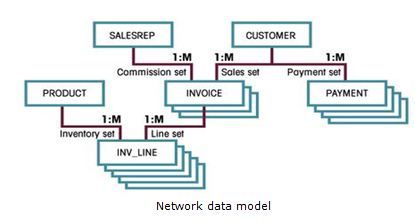Network Data Model in DBMS
The network model was created to represent complex data relationships more effectively than the hierarchical model, to improve database performance, and to impose a database standard.
In the network model, the user perceives the network database as a collection of records in 1:M relationships. However, unlike the hierarchical model, the network model allows a record to have more than one parent.
While the network database model is generally not used today, the definitions of standard database concepts that emerged with the network model are still used by modern data models.

Network Data Model In DBMS
Some important concepts that were defined at this time are:
• The schema, which is the conceptual organization of the entire database as viewed by the database administrator.
• The subschema, which defines the portion of the database “seen” by the application programs that actually produce the desired information from the data contained within the database.
• A data management language (DML), which defines the environment in which data can be managed and to work with the data in the database.
• A schema data definition language (DDL), which enables the database administrator to define the schema components.
Network Data Model Advantages
The Network Date Model has the following advantages:
1. Conceptual simplicity
2. Handles more relationship types
3. Data access flexibility
4. Promotes database integrity
5. Data independence
6. Conformance to standards
Network Date Model Disadvantages
The Network Model has the following disadvantages:
1. System complexity
2. Lack of structural independence
You May Also like:
Hierarchical Data Model in DBMS
Relational Database Model in DBMS
The Entity Relationship Model in DBMS
The Object-Oriented (OO) Data Model in DBMS


